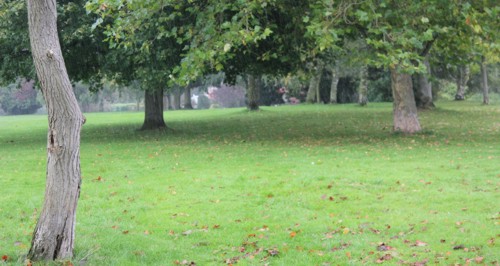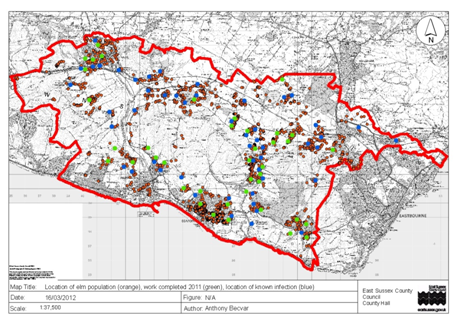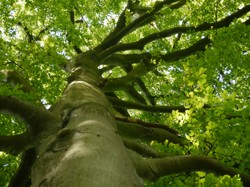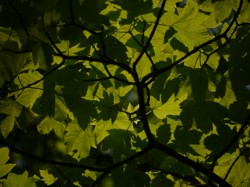Cultural Value of Trees

SEI has been developing a number of projects on this theme in partnership with the Food and Environment Research Agency (FERA). The work sits between SEI's Managing Environmental Systems and Transforming Governance themes making recommendations on how to respond to emerging issues around tree health in relation to invasive pests and diseases. The SEI team includes geographers, ecologists and citizen science experts focussed on identifying different stakeholder’s knowledge and potential contribution to the identification, control and management of invasive diseases in the UK.
The team have currently completed one project on Dutch Elm management and is currently undertaking follow-on work investigating cultural benefits from trees for citizens across England.
Read about these projects here.
Dutch Elm Disease Management
Dutch Elm Disease Management in East Sussex
The DED Management in East Sussex (DED-MES) project undertook an integrated, interdisciplinary assessment of the non-statutory interventions against DED carried out by East Sussex County Council (ESCC) on the south coast for the last 40 years and analysed potential future scenarios of management. The project carried out during 2012 represented a collaboration between SEI, FERA and The Dutch Elm Disease Office for ESCC.
The DED-MES project team worked together with the DED Officer for ESCC and the Elm Partnership to answer the following research questions:
- What have been past management strategies of DED in the Control Area?
- What information was used to decide these approaches?
- What lessons can be learned for future management?
- What are the social and cultural values of Elm trees?
- How do residents value the remaining Elm trees?
- Does this differ between geographic areas, participant age, and involvement with Elm tree management?
- What are plausible future scenarios for the management of Elms in the DED Control Area?
- What are the potential social and cultural costs and benefits of the identified scenarios?
The Elm Partnership is a group whose members are those organisations, companies, and local authorities that are directly or indirectly involved in the management of DED in the area (ESCC, 2012). The partnership was active for a long time, but became less functional in recent years. In July 2012 the new DED officer in ESCC invited all members to a meeting to re-invigorate the partnership. This meeting indicated that all members were still very interested in, and engaged with, the management of DED and agreed there was a need for future management of the disease. However, members had different opinions on the best future strategy. They raised questions including: Are we delaying the inevitable? Is the current management approach sustainable in the long term?
The DED-MES project facilitated a discussion about future management strategies in the area during two meetings with the Elm Partnership. Two rounds of on-street engagement with residents provided the means to gather complementary information around perceived benefits and costs of having elm trees in the area.
Download the Final report - Dutch Elm Management in East Sussex - 18th Oct 2013.pdf (PDF ![]() , 3,417kb) or read the summary findings below.
, 3,417kb) or read the summary findings below.
Summary Findings
The outbreak of a newly introduced Dutch Elm Disease (DED) fungus in the 1970s led to the death of most mature elm trees across the UK, but in some parts elm trees survived (Brasier, 1996; Tomlinson and Potter, 2010).
In Brighton and Hove and in some parts of the South Downs mature trees remain mainly due to geographic advantages. East Sussex County Council (ESCC) established the DED control programme in 1971 (ESCC, 2012) to manage the disease. However, due to a mixture of political and financial limitations the disease was not eradicated from the area after the first epidemic (Tomlinson and Potter, 2010).
The beetle population that spreads the disease decreased with the decline in available breeding grounds, as mature elm trees were especially affected by DED. Across East Sussex the beetle population may now increase again over time as younger elm trees reach maturity. Management of DED in the Brighton area, within the ESCC control zone, and in Eastbourne has seen changes over the years; in responsibility, budgets and man power. The latest wave of increasing beetle numbers has presented itself in recent years, but the population currently seems to be reducing again. This has led to a reflection on the strategy used in the past years to see whether a more targeted approach that prioritises particular areas and trees might be more cost effective.
The DED Management in East Sussex (DED MES) project, reported on here, supported this reflection by undertaking an integrated, interdisciplinary assessment of the non-statutory interventions against DED carried out by East Sussex County Council (ESCC) on the south coast for the last 40 years and analysed potential future scenarios of management: What have been past management strategies of DED in the Control Area? What are the social and cultural values of Elm trees? And what are plausible future management scenarios for the management of Elms in the DED Control Area?
Three different management approaches were compared:
- Business as usual, characterised by sanitation felling and burning. This process involves identifying disease-affected trees within four to six weeks of the symptoms becoming apparent and in this window of opportunity felling the tree and burning all the associated material.
- Doing nothing, which will let the disease affect all elm trees in a relatively short period of time.
- Priority approach, which targets particular areas and trees. Rather than immediately felling and removing the tree it relies on allowing some infected trees to be utilised preferentially by beetles for feeding and egg laying rather than moving to unaffected trees. Finally trees are destroyed just before the beetle larvae emerge as adults thereby reducing beetle populations and preventing migration of the disease. It has been seen as a more cost effective approach to reduce the beetle population, and hence spread of the infection, with the minimum felling of elms.
Spatial epidemiological modelling (undertaken as a separate part of the project, and is described elsewhere, Cunniffe, 2013) showed that the least number of trees will die under the priority approach and that it can slow down the impact of DED. An economic assessment also showed that costs will be least under this approach because elm trees will live longer. Two rounds of on-street engagement produced an informative and strong starting point to attempts at gauging public values and perceptions of tree health linked to which management approach they would support. Participants were also in favour of the priority approach.
The success of a more targeted approach however depends on a number of factors. Firstly there is a gap in awareness of tree health. On-street engagement highlighted the lack of knowledge about trees in general and Elm trees in particular. It was quite striking how local inhabitants were not aware of the number of elm trees that still remained in their village/town/city, despite often being very informed about the disease. Perhaps this increased knowledge of the disease over the tree itself comes from the information sources available to them, such as newspapers and television programmes, which may tend to focus on outbreaks and management rather than presence and abundance of existing stock – the narrative after the outbreak story.
Secondly, data has to be available for monitoring the status of trees and beetle population. This will allow the gathering of evidence on whether the chosen approach is working or needs adapting. Citizen science could help with the baseline data collection about the current status of trees as well as monitoring a large number of trees spread over a wide area, such as the control zone in East Sussex.
Thirdly, overall coordination from central government appears important in order to maintain pest and invasive species management as a local strategic priority (within varying local priorities) by providing a clearer framework to operate within. The devolution of control to local authorities and other organisations (including charities and private sector groups) means that the priority and funding allocated to DED management can vary across geographic and administrative areas through time. This uncertainty results in sub-optimal control of the spread of the disease.
This projects findings indicate that sufficient financial and human resources are needed to plan, coordinate and monitor the management of tree health across large areas. As tree diseases do not follow administrative boundaries it is also critical to design collaboration across administrative and organisational boundaries. This in turn will ensure a continuous management of tree health and the potential eradication of diseases affecting tree species in the UK.
Download the Final report - Dutch Elm Management in East Sussex - 18th Oct 2013.pdf (PDF ![]() , 3,417kb)
, 3,417kb)
Contact:
Steve Cinderby
Email: steve.cinderby@york.ac.uk
Twitter: @s_cinderby_SEI
Tel: 01904 322994
Annemarieke de Bruin
Email: annemarieke.debruin@york.ac.uk
Tel: 01904 322888


